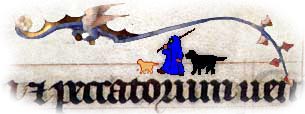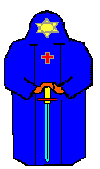 Essays and Reviews Essays and Reviews |
|
Many authors dismiss the book as worthless material for the Order history. As a whole, I agree. But regarding" my "Memorabilia, I don't. My copy of Memorabilia was once a possession of Dr W. E. Carnegie Dickson, V. H. Fra. Fortes Fortuna Juvat, one of the Chiefs of Stella Matutina. He personally knew many GD members very well. And he left many marginal notes. Some of them are valuable information. For example, de Steiger wrote about Brodie-Innes in p.270. Her footnote says "Mr. Brodie-Innes was a W. S. in Edinburgh and he lived also in London, as he practised in English ecclesiastical law in both countries". Carnegie Dickson, with red ink, erased the word W.S. and wrote "advocate and barrister - W.E.C.D.". Many authors refer Brodie-Innes as the Writer to the Signet, but judging from this, he was really an advocate in Edinburgh, and a barrister in London. I find the ex-libris of Carnegie Dickson in my copy. It's a fine one, depicting thistle, Old College of the University of Edinburgh, and the British Museum. The implication is obvious. Born in Scotland, educated at Edinburgh, and initiated into the Golden Dawn. W. E. Carnegie Dickson died in 1954. It seems his library was dispersed
among occult students. One of his books came to as far as Japan. It's a
strange world. |
Book Review J. W. Brodie-Innes The Tragedy of an Indiscretion (The Bodley Head, London, no date) If you expect in this book an illumination, lucid analysis on occultism, or strange folklore about Scottish witchcraft, surely you'll be disappointed. Believe it or not, this work, whose author was once the Imperator of Amen-Ra, has nothing to do with magic! It is a pure legal court drama. G.H.Fra.Sub Spe was in his real life a lawyer, so maybe not so surprising. But court drama? We read Brodie-Innes's other stories, such as The Devil's Mistress, For the Soul of a Witch for amusemnt or information. The Tragedy of an Indiscretion, perhaps a rare book, is to be read by the detective story fans, not by us. |
|
Translating The Sea Priestess The first novel I read through in English was Dion Fortune's The Sea Priestess. Perhaps I was a bad boy. As a College student who majored English Literature, I should have read something more normal. My professor frowned, not because I chose a strange book, but because he did not recognize the title, author and publisher. To describe the beauty and power of The Sea Priestess is beyond me. You all know well. Rather I would like to tell you a strange story surrounding the translation script of The Sea Priestess. In 1990 I decided to translate The Sea Priestess into Japanese. And suddenly I was aware of the similarity between my area and Dickmouth. At that time I was living in the Southern Part of Japan, Munakata Area of Kyushu. There is a Shinto shrine named Munakata Taisha. This shrine is one of the oldest in Japan, and dedicated to the Three Goddesses of Sea. In the neighbouring district are small fisherman's towns named Kanezaki. (Kane means bell : zaki, the head. the Bell Head) and Kounominato( meaning the harbour of gods). Those towns face to a certain area of Sea of Japan, and the area is called Genkainada( meaning Dark Sea). Naturally I explored the district thoroughly, hoping I would find a sea priestess. I found none. But I found an interesting festival at Miyajidake Jinja, a sea side shrine ten miles away from Munakata Taisha. The festival is held annually, choosing a girl as a messenger from Sea God. The girl is dressed in ancient gorgeous kimono, and carried by a kind of rickshaw from shore to the shrine. There is a phrase in The Sea Priestess, chapter XXIV. Wilfred Maxwell was going to spend a night of meditation at the cave in Bel Knowle when Le Fay Morgan " produced a kind of kimono made of coarse white shantung which I fancy is native-woven and native-bleached". I am not sure whether Dion Fortune knew Japanese Shinto. But it is a fact that in her later period she was researching the paganism. So it is not so a wild guess that she knew. Shinto is the only living paganism you can find in civilized countries: in other words, the only polytheism not crushed by the Christianity. The similarity ends not here. Dion Fortune could not find a publisher for her masterpiece. I could not find a publisher for my translation script.
So Japanese The Sea Priestess is still in my FDD. Should I publish
it at my own expense, like Fortune did? And would it be praised as a masterpiece
after my death?
|
|
"Very soon curious things began to happen. We became most desperately afflicted with black cats. The caretaker next door was engaged in pushing bunches of black cats off doorstep and window-sill with a broom, and declared he had never in his life seen so many, or such dreadful specimens. The whole house was filled with the horrible stench of the brutes". Fortune suggested this was a kind of black magic which Moina Mathers cast ; both women had been looking askance at each other. Crowley once wrote a similar thing in Equinox vol.1.no.1.(190'7). In his short story "At the Fork of the Roads", a young magician is tormented by a succubus sent from his enemy. He asks his Master for advice. And the Master works a strange trick, as follows: "They went out into the city, and purchased a certain drug of which the master knew. At the very time that she was calling at the flat, they were at the boarding-house where she lodged, and secretly distributing the drug about the house. Its function was a strange one : hardly had they left the house when from a thousand quarters came a lamentable company of cats, and made the winter hideous with their cries." Crowley also wrote in his "Confessions" that the story is "in every detail a true account of one episode of this period". The Master is Allan Bennet. Comparing Fortune's account with Crowley's, it seems Moina Mathers used the same trick of cat gathering drug, but we are not sure. It is also probable Fortune made up the whole story based on Crowley's. Or was the cat gathering a traditional harassment adopted by the Adepts of the Golden Dawn? The Japanese can easily identify the drug. In Japan, the drug is very popular,
and it is called Matatabi. Academically, Actinidia polygama. Matatabi produces
the very effect Fortune and Crowley describes. It is far much stronger
than catnip. Matatabi is used as a tonic in China and Japan. You can buy
it at Chinese Pharmacy.
|
|
held at Tokyo, Nov.22-23, 1998. True, the fee was very high. 10,000 yen (almost 80 dollars). But considering the rent fee of the hall and the number of expected participants, this was inevitable. The rent fee was almost 4,000 dollars a day, and the participants were 60. Many leading occultists in Japan came to this festival. The most striking figure was Mr. Akiba, the head of I.O.S., a GD type magical order. Although the Japanese are small in statue compared to the Westerner, Mr. Akiba is an exception. More than 6 foot and 250 pounds, with torso like a wrestler, with face not unlike Schwarzenegger, Mr. Akiba seemed a hero of ancient mythical tale. The festival began with the ritual performed by Mr. Akiba dressed in Egyptian style. And the opening words was announced by Mr. Eguchi, a writer and translator of many occult books. He looked like Rowan Atkinson the British comedian. These two men were both chairmen of this event. Workshop and discussion went on. Mr. Eguchi's speech on Levi was interesting. He explained the relationship between Anna Kingsford and Baron Spedarieri (Levi's disciple), and how Westcott got the material later published as Magical Ritual of the Sanctum Regnum through Edward Maitland. Mr. Eguchi digressed much, saying "a magician needs a mysterious woman. Levi had a lady in a carriage. Westcott had Anna Sprengel. Gerald Gardner had Old Dorothy. A. O. Spare had Mrs. Patterson". And he turned to Mr. Akiba and said " I have no objection to I.O.S.. It's a first rate order except one point. You have no mysterious woman. All you have is a big, awkward Golem! " The hall was filled with laughter. All in all, the festival was a success. Many profitable talk were exchanged.
I hope such event often held in Japan. (A)
|
|
Q. What kind of organization is the O.H. ? A. Officially, O.H. is a Golden Dawn style magical order which consists of first and second orders. But in truth, it is a paper order founded on several jokes and hoaxes. But the members wrote many books on magic and translated standard works. They made the name of O.H. famous through these activities. Several serious magical orders in Japan were created under the influence of O.H.
|
 Memorabilia
was published by Rider in 1927, a year after the publishing of Yeats's
Autobiographies. The vow of secrecy was already broken. Perhaps
the respectable old lady still wanted to avoid the embarrassment associated
with the name of Golden Dawn; the damned case of Horos Trial, or the Great
Beast of Sunday Papers.
Memorabilia
was published by Rider in 1927, a year after the publishing of Yeats's
Autobiographies. The vow of secrecy was already broken. Perhaps
the respectable old lady still wanted to avoid the embarrassment associated
with the name of Golden Dawn; the damned case of Horos Trial, or the Great
Beast of Sunday Papers.
 No, it is not the trouble Miss Horniman made, but the famous cat gathering Dion Fortune described in her Psychic Self-Defence(1930), as it
goes:
No, it is not the trouble Miss Horniman made, but the famous cat gathering Dion Fortune described in her Psychic Self-Defence(1930), as it
goes: Report of the Golden Dawn Festival 111
Report of the Golden Dawn Festival 111
 FAQ
FAQ